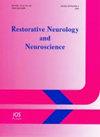Ischemic Cerebrovascular Accidents in HIV Patients on Antiretroviral Therapy: Clinical, Paraclinical And Prognostic Aspects in The Neurology Department of The University Hospital Center of Conakry
IF 1.6
4区 医学
Q4 NEUROSCIENCES
引用次数: 0
Abstract
Introduction: Ischemic stroke (Stroke) constitute, due to the demographic and epidemiological transition, a real challenge for developing countries and HIV infection, a real public health problem in these countries. The objective of our study was to describe aspects of clinical, paraclinical and prognostic ischemic stroke in people living with HIV (PLHIV) on antiretrovirals (ARVs). Material and methods: This was a prospective study of the descriptive type lasting 6 months from January 1, 2022 to June 31, 2022, relating to ischemic cerebrovascular accidents (DALYs) in HIV patients on ARVs.Were included patients admitted or hospitalized in the service for seropositive ischemic stroke under ARV for an average duration of 35.5 months. Patients recently put on ARVs and those with an obvious cause of DALY such as (diabetes, uncontrolled hypertension, emboligenic heart disease) were excluded. Results: During our study period, 336(94%) patients were listed. Among them, 20 have ischemic stroke associated with HIV on ARVs, i.e. 6%. This study showed that the average age of onset of ischemic stroke in PLHIV on ARV was 49 ± 11.6 years with a sex ratio F/M of 1.22. The risk factors were high blood pressure 13 (65%), diabetes 05 (25%), followed by alcohol 04 (20%). HIV type 1 was represented at 100%, then 16 (80%) of our patients were at WHO stage III with a CD4 count between 200 and 300 cells/µl09 (45%). The therapeutic line of ARVs was dominated by TDF+3TC+EFV at 14 (70%) followed by AZT+3TC+LPV/r at 04 (20%) and the average duration of patients on ARV was 35.5 months. The favorable evolution was marked 13 (65%), followed by a death in (10%) or 02. The location on the cerebral scanner was dominated by the sylvian artery in 12 (60%) of cases followed by the anterior cerebral artery (ACA) 06 (30%) and the posterior cerebral artery ( PCA) 02 (10%). Conclusion: Ischemic stroke in HIV patients on ARVs requires early management and regular monitoring抗逆转录病毒治疗的HIV患者缺血性脑血管事故:科纳克里大学医院中心神经内科的临床、临床旁和预后方面
导言:由于人口和流行病学的转变,缺血性中风(中风)对发展中国家构成了真正的挑战,艾滋病毒感染是这些国家真正的公共卫生问题。本研究的目的是描述抗逆转录病毒药物(ARVs)治疗的HIV感染者(PLHIV)的临床、临床旁和预后缺血性卒中的各个方面。材料和方法:这是一项为期6个月的描述性前瞻性研究,从2022年1月1日至2022年6月31日,涉及抗逆转录病毒药物治疗的HIV患者缺血性脑血管事故(DALYs)。纳入在ARV治疗下因血清阳性缺血性中风入院或住院的患者,平均持续时间为35.5个月。最近服用抗逆转录病毒药物的患者和有明显DALY原因的患者(如糖尿病、未控制的高血压、栓塞性心脏病)被排除在外。结果:在我们的研究期间,共有336例(94%)患者入选。其中,在抗逆转录病毒药物治疗中发生与HIV相关的缺血性中风20例,占6%。本研究显示,抗逆转录病毒感染者发生缺血性卒中的平均年龄为49±11.6岁,性别比F/M为1.22。危险因素是高血压13(65%),糖尿病05(25%),其次是酒精04(20%)。艾滋病毒1型占100%,然后16例(80%)患者处于世卫组织III期,CD4细胞计数在200至300个细胞/ μ l09之间(45%)。ARV的治疗线以TDF+3TC+EFV为主,占14(70%),其次是AZT+3TC+LPV/r,占04(20%),患者平均服药时间为35.5个月。有利的进化标记为13(65%),其次是死亡(10%)或02。脑部扫描位置以左动脉为主12例(60%),其次为大脑前动脉(ACA) 06例(30%)和大脑后动脉(PCA) 02例(10%)。结论:抗逆转录病毒药物治疗的HIV患者缺血性卒中需要早期治疗和定期监测
本文章由计算机程序翻译,如有差异,请以英文原文为准。
求助全文
约1分钟内获得全文
求助全文
来源期刊
CiteScore
5.40
自引率
3.60%
发文量
22
审稿时长
>12 weeks
期刊介绍:
This interdisciplinary journal publishes papers relating to the plasticity and response of the nervous system to accidental or experimental injuries and their interventions, transplantation, neurodegenerative disorders and experimental strategies to improve regeneration or functional recovery and rehabilitation. Experimental and clinical research papers adopting fresh conceptual approaches are encouraged. The overriding criteria for publication are novelty, significant experimental or clinical relevance and interest to a multidisciplinary audience. Experiments on un-anesthetized animals should conform with the standards for the use of laboratory animals as established by the Institute of Laboratory Animal Resources, US National Academy of Sciences. Experiments in which paralytic agents are used must be justified. Patient identity should be concealed. All manuscripts are sent out for blind peer review to editorial board members or outside reviewers. Restorative Neurology and Neuroscience is a member of Neuroscience Peer Review Consortium.

 求助内容:
求助内容: 应助结果提醒方式:
应助结果提醒方式:


